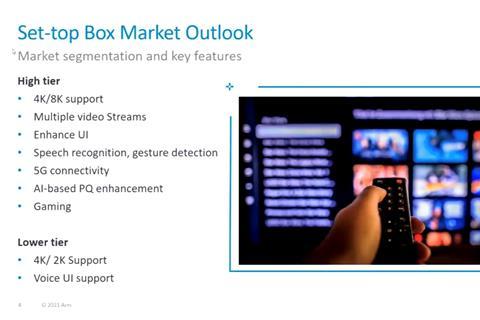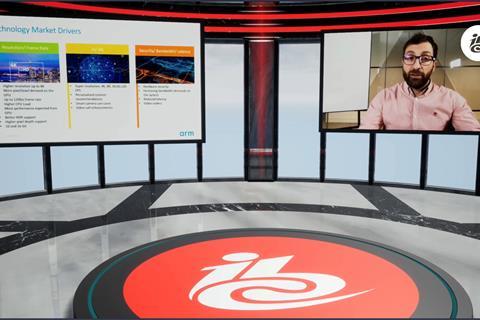The home device market has seen significant growth over the past couple of years, with more content and services being streamed into such devices than ever before. How are the trends around the technology and use-cases driving development?
In this recorded IBC Digital session Andrea Cantone PhD, senior manager, strategy and marketing at ARM, dives into future market and technology trends in detail. He considers future requirements for DTV, set-top boxes (STB) and OTT devices across different forms of compute with more processing power, AI and Machine Learning (ML) workloads, security and new features like 8K. He also outlines what the home device market needs to do to service the demands of this growth.

Cantone segments the market into a high tier and the lower entry tier. “The high tier has features such as 4K/8K resolution and multiple video streams, as well as upcoming features that will be released in the next few years like an enhanced UI, speech recognition and gesture detection, 5G connectivity or AI-based quality enhancement,” he explains.
Low tier is defined as the majority of the current market, with 4K or 2K resolution support, as well as some basic voice UI support, mostly through a remote control.
Content is still king in these markets and is driving the increase in resolution in particular.
“The personalisation of content, simplification of choice, as well as easier and simpler UI is going to drive differentiation.”
“There is a movement now from 4K to 8K resolution,” says Cantone. “There is also the development of AI and machine learning capabilities to bring that resolution up, even if it’s not delivered natively.”
This is enabling better experiences in terms of content delivery and also in terms of customer choice.

“So for people to differentiate, we’re looking at different customer experiences,” Cantone says. “The personalisation of content, simplification of choice, as well as easier and simpler UI is going to drive differentiation.”
As well as intelligent recommendations, Canton suggests higher resolution for menus will give users the capability to flick to content in easier and simplified ways.
AI and ML features are being brought to bear on the development of the user experience, particular in terms of gesture recognition and face tracking, driven not just by the boom in fitness devices entering the home during the pandemic, but also because “a lot more people are spending time in front of the TV”.

“Gaming is kicking off; you can access it via the cloud,” adds Cantone. “You don’t need a console any longer to play some of your games. We’re looking at bringing that experience to the next level. We want to reduce the latency, have what we call a native game experience where you run the game on the [home device] itself to keep offering the advanced UI and experience [people have become used to].”
Then there is the smart home applications, such as alarms and device control, as well as the widespread acceptance now of video communication. The STB can be a central point for controlling all these home-based functions, says Cantone.

“What we’ve seen up to now is a big shift in the importance of a set-top box, which is still mainly driven by content, but is expanding its capabilities and features to cover a lot of applications from fitness to gaming, to smart home and smart camera applications. This is actually driving the technology to the next level.”
AI and ML are also being deployed in the area of security, not just in terms of content watermarking, but also security around algorithms and the protection of applications and browsers from attack.
Big shift
Cantone says to address all these trends, ARM is shifting from “a product evolution focus to use-case driven solutions”.

“Here at ARM when we talk about this shift, we talk about Total Compute solution, which is a complete system solution that gives you not just the physical and scalable IP that you require for the product itself, but also the tools and the software ecosystem that you require to design your premium devices, as well as some common standards and support that you need to make those solutions scalable and efficient,” he adds. “We’re looking at delivering real-life use cases promptly that enables you to reduce your time to market and be efficient during your development.”
In summary, Cantone says when operators and OEMs are looking for the next product, what is important is to think about a scalable solution. “This should be a scalable system that you can use across different tools, to enable you to deliver different features,” he advises. “Also think about a platform that can be in the market for a quite extensive amount of time, between three to seven years. Think about how you can develop your security and your ML and AI algorithms within the ecosystem.”
At the end of the session, Cantone invites IBC Digital viewers to contact him for questions or comments and provides links to more extensive reading on this subject.
Watch How future market and technology trends will define the home device market on-demand on IBC Digital
























No comments yet